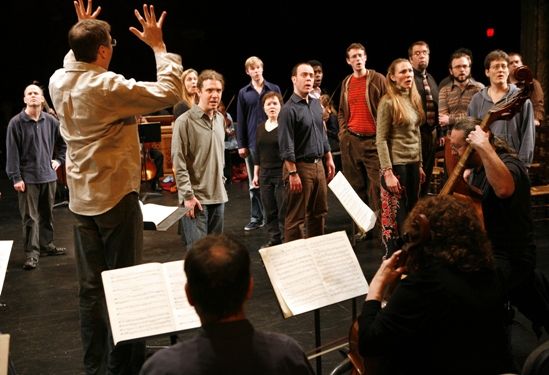Jonathan Miller’s staging of J.S. Bach’s St. Matthew’s Passion is the most faithful and moving interpretation of this classic work that I have ever experienced. Composed in the 1720’s for the Good Friday service, the St. Matthew’s Passion is one of Bach’s masterpieces. Operatic in scope, but intimate in perspective, the Passion is set to texts taken from St. Matthew’s Gospel, woven together with devotional texts written by Christian Henrici, a German writer with whom Bach worked closely. The music is composed for two orchestras and two choirs, with a full complement of solo voices and instruments as well. The music shifts from complicated counterpoint to direct hymn-like melodies, even as the perspective moves between the Evangelist’s narration, Jesus’ words, the shouts of the crowd, and the believer’s reflection on the events. Bach ties it all together in a way that is both magnificent and completely natural; Miller’s simple, yet inventive staging honors this work in a way that allows it to be seen and heard more clearly by modern audiences who may have grown resistant to its power.

I have seen Miller’s staging of the Passion on two different occasions and both times I was struck by the timelessness of Bach’s work and the respectful and honest way it is unveiled by this production. Miller’s staging is extremely simple. The two orchestras and two choirs form a large circle on the stage, facing one another. In the center are a few very simple props: a table that serves both for the Last Supper and for Pilate’s bench, a few chairs. Everyone is dressed in unremarkable street clothes. A few small props are carried in by soloists, but many things are mimed. The two choirs, which at various times portray the crowds, Jesus’ friends, and the voice of the watching believer are seated randomly, some on chairs, a few on the sides of the stage, or stand or walk around. The soloists portraying Jesus, the Evangelist, Peter, Mary Magdelene, and others sing in the center of the circle, moving to different areas of the stage as the story demands.
The choral and solo singers all sing without any music, something that allows them to act very naturally and move freely. Removing a barrier as small as a musical score has the immediate effect of increasing the intimacy and connection between the musician and the listener. The mish-mash of street clothes create another interesting effect. There is no apparent continuity – some wear nicer street clothes, others wear tennis shoes and wrinkled shirts. At first I found myself wondering why some people would choose to perform in certain outfits, no matter how comfortable, but as I continued to watch the various performers and their individual reactions, which were easier to follow as they all looked different from each other, I found myself thinking of all these different souls and their reactions to Jesus and his Passion story. The goal of most concert wear, especially for choirs and orchestras is to mask the individual in service of the whole. While the choirs and orchestras sang and played with remarkable precision and unity, I was yet reminded that they were made up of individual souls all seeking to engage with this story and this Savior. We believe these are regular people caught up in a story much bigger than themselves.
The singers were not the only ones liberated from their scores. During a number of the arias, the obbligato instruments which dueted with the soloists often stood up from behind their stands and moved to join the soloists as they sang to another character or to each other. The physical movements of the vocal and instrumental soloists often mimicked the intertwining of their musical parts in a fascinating way. A good example of this was the aria, “Have mercy, Lord” (“Erbarme dich”), which was beautifully sung and played by countertenor Daniel Taylor and violinist Robert Mealy. This aria follows immediately after Peter has denied Jesus three times, heard the cock crow, and remembered Jesus’ words predicting his betrayal. As Peter sits weeping, the soloist and the violinist weave around him, expressing his sorrow, and turn to Jesus to plead for mercy for him (“have mercy, Lord, ah, let my tears persuade thee”). Besides the dramatic expression of the music, this staging also emphasizes the beauty and complexity of the two solo lines Bach has woven together.
One of the great advantages of this interpretation of the Passion is that it shows so clearly the relevance and accessibility of Bach’s work for a modern audience. Bach certainly uses the musical languages of his day, but he does this so deftly and with such an innate sense of their power and dramatic usefulness that they do not seem outdated or incomprehensible. A good example of this is his use of counterpoint to knit together two opposing ideas in one piece of music. In the alto/soprano duet with chorus, “Alas, my Jesus now is taken” (“So ist mein Jesus nun gefangen”), the soloists express the sorrow of Jesus’ humiliation (“Moon and stars for grief the night forsaken”) while the chorus reacts in shock and anger with increasing agitation (“Free him! Stop there! Bind him not!”). In all of the staging and musical interpretation there was never a hint of irony or the need for a modern “re-telling” of this story of the Passion. The complete commitment of the production and all of the performers was both refreshing and incredibly moving. The respectful unveiling of this masterful work was more revelatory and believable than any re-interpretation could have been.
Behind Bach’s sublime music, there is also great power in the text of this Passion. Sung for this performance in Robert Shaw’s simple yet poetic English translation, Henrici’s text manages to weave together both the dramatic story (in Matthew’s words) and our corporate and personal response to this story. The two choruses, in particular, swing between portraying the jeering crowds around the cross and the humble sinner overwhelmed by the mercy granted to him. The highpoint of this work for me always comes right after Jesus has died, when the chorus sings these words without accompaniment, softly, intensely, and as one voice:
When comes my hour of parting,
Then part You not from me.
When shades of death are dark’ning,
Your love my light shall be.
When anxious fears shall rend me,
And break my heart in twain,
O comfort and befriend me,
Through Your own grief and pain.
This piece always reflects for me the intensely personal nature of Jesus’ salvation, and you could sense the rapt attention of everyone listening. I was not the only one wiping away tears.
The quality and commitment of all of the musicians was very evident. As the Evangelist, tenor Rufus Müller was a particular standout. Many tenors who sing the Evangelist have a thinner, almost nasal tone to their voice, but Müller’s voice is warm and rich. At the same time he makes use of many different vocal colors and textures to illuminate the text he is singing. The story came to life in the sensitivity with which he turned certain phrases, such as the stark quality of the “cock crow” line, and his economy of gesture which allowed certain dramatic gestures, his pointing to Judas, for example, to impact all the more.

Curtis Streetman, the bass who played Jesus, has a compelling physical presence which he used to good effect. But his voice lacked some of the resonance of the other soloists, which meant that his lines did not always ring out like they should have.
Mezzo-soprano Phyllis Pancella, with a rich, warm sound, was particularly good in “Ah, now is my Jesus gone!” (“Ach, nun ist mein Jesus hin”). The other voice I particularly liked was tenor Nils Brown. Daniel Taylor, the countertenor, sang with a ringing tone and excellent diction, and soprano, Suzie LeBlanc, and baritone, Stephen Varcoe, gave particularly sensitive interpretations of a number of arias.
British conductor, Paul Goodwin, led the Clarion Orchestra and the REBEL Baroque Orchestra with precise attention to musical detail and brisk but sensitive tempi. There were a number of excellent instrumental soloists as well, with Lisa Terry’s viola de gamba solo a particularly good example.
In Bach’s church in Leipzig, all of the Lenten services preceding the Good Friday service contained no music at all. Imagine then the effect of the St. Matthew Passion on the enraptured congregation after such a fast. The audience for BAM’s production of the Passion may not have realized they had been fasting as well until this performance evoked some of that original wonder and awe.



